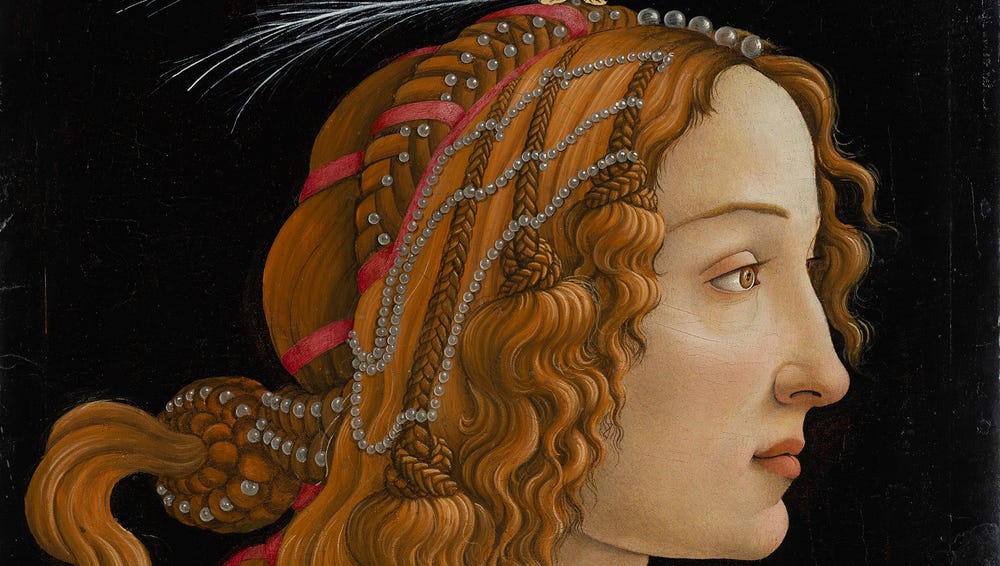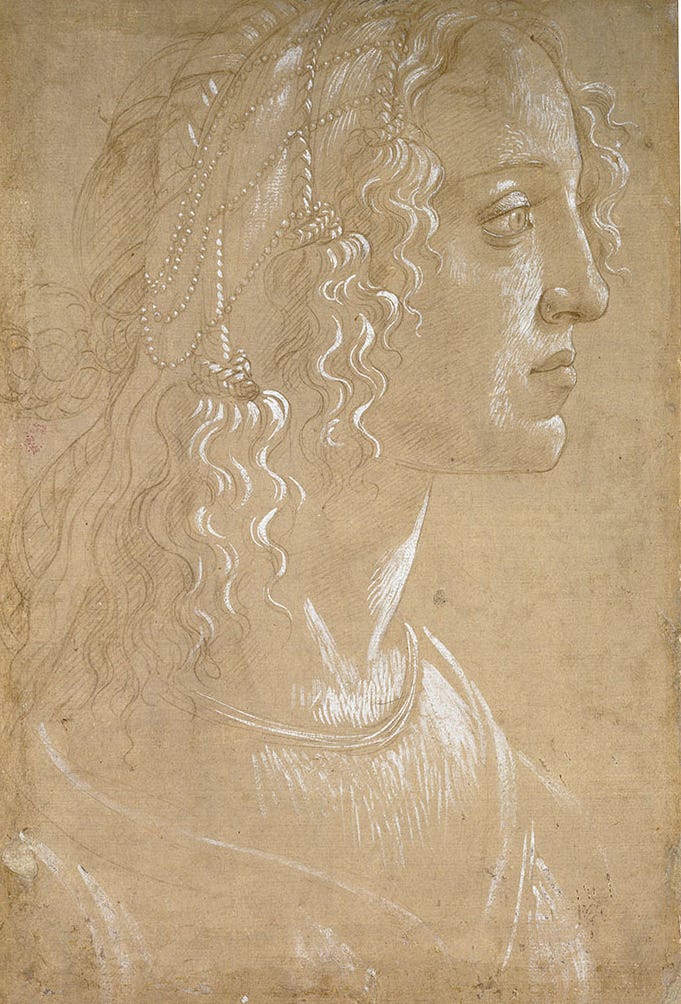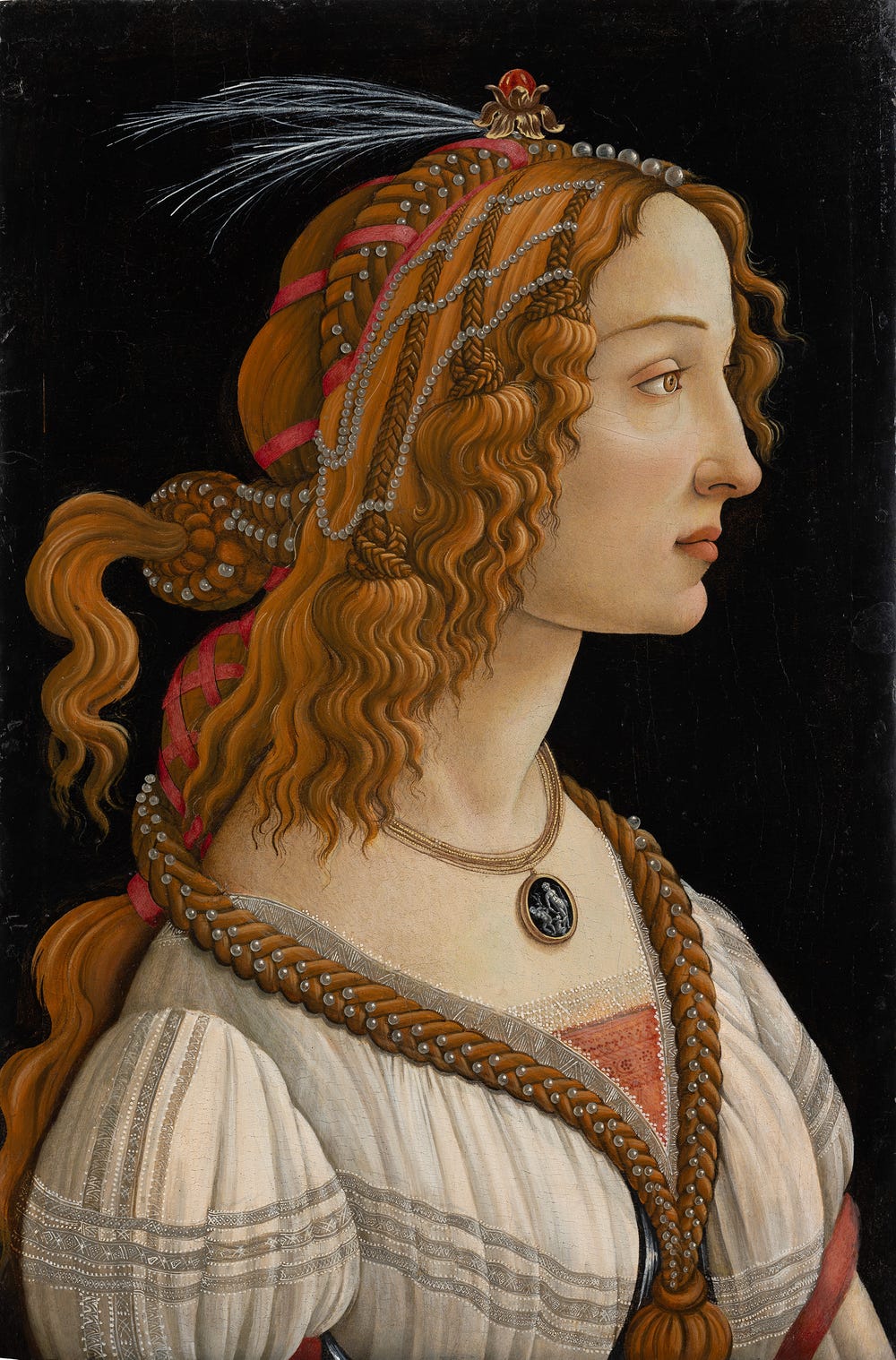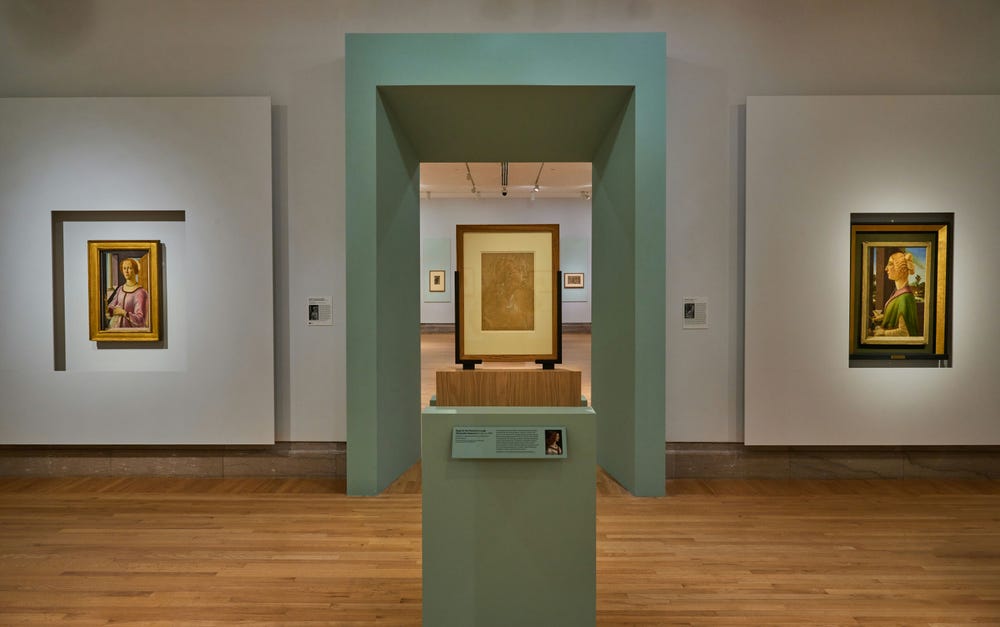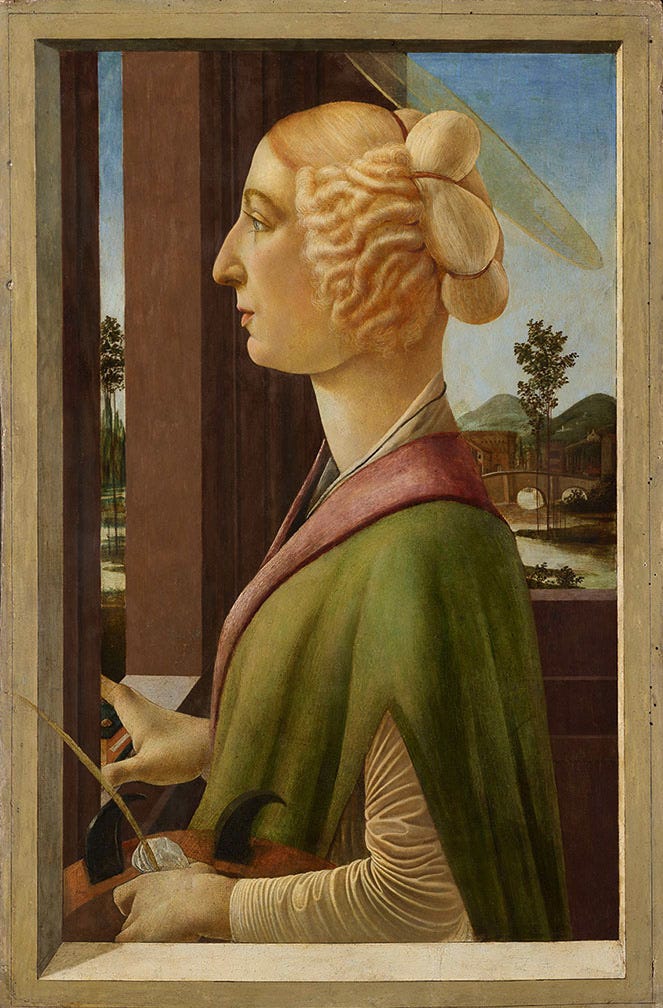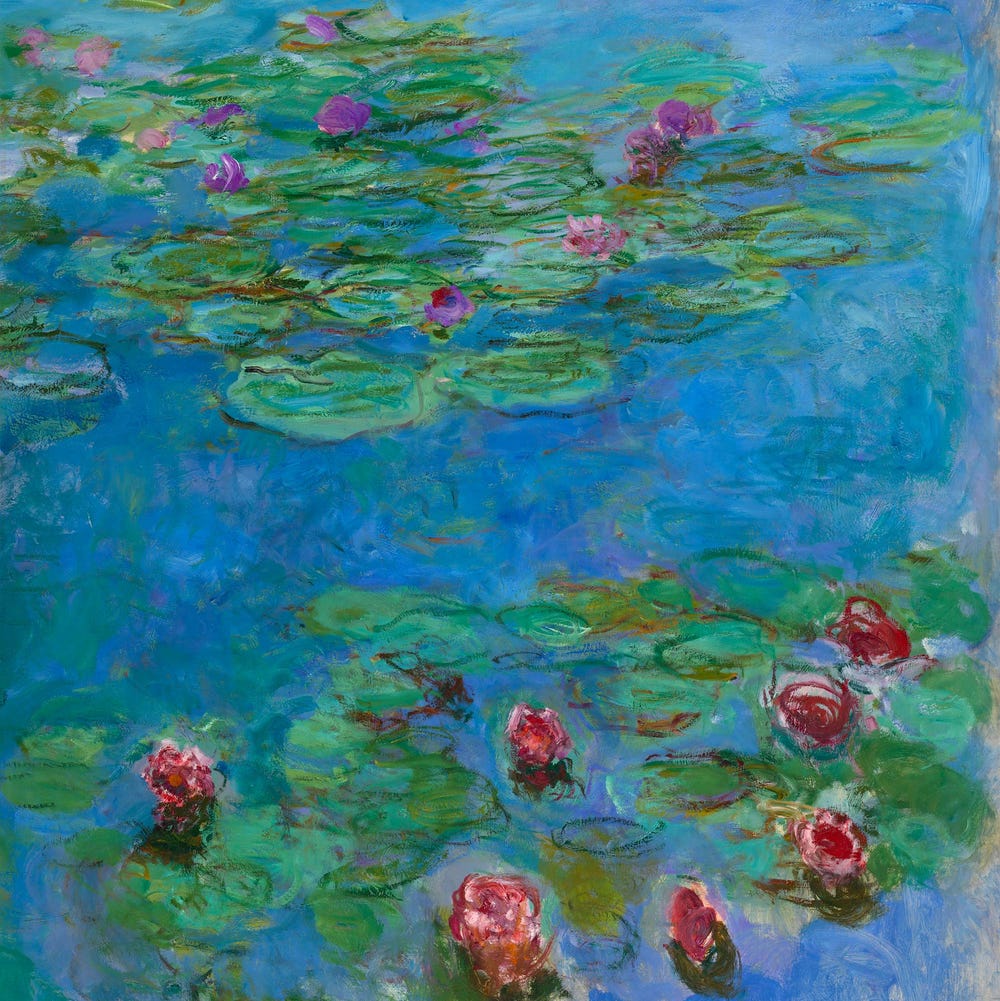The Hidden Meanings in Botticelli’s Hair
By Emanuele Lugli, assistant professor, Stanford University
January 11, 2024
Sandro Botticelli, Idealized Female Portrait (Portrait of Simonetta Vespucci as a Nymph) (detail), ca. 1485. Tempera on panel, 32 1/16 × 21 5/16 in. (81.8 × 54.2 cm). Städel Museum, Frankfurt am Main (936)
At first glance, there is nothing odd about this drawing of a woman in profile: lips pressed, neck tall and proud, eyes fixed forward. It’s the familiar hallmark of Renaissance art: a poised woman, beautifully detailed. Yet, look on and something else is revealed.
Sandro Botticelli (Italian, Florence, ca. 1445–1510), Study for the Portrait of a Lady (Simonetta Vespucci) (recto), ca. 1480. Metalpoint heightened with white, on light brown prepared paper, 13 3/8 × 9 1/16 in. (34 × 23 cm). The Ashmolean Museum of Art and Archaeology, Oxford, UK. Bequeathed by Francis Douce, 1834, WA 1863.613 © Ashmolean Museum
Like most studies, Study for the Portrait of a Lady (ca. 1480) helped Sandro Botticelli (ca. 1445–1510) prepare for a painting. This now hangs in the Städel Museum in Frankfurt, Germany. It is a big, stunning panel, bursting with colors. Still, I favor the drawing, smaller and fainter though it may be, for it’s the sheet Botticelli held in his own hands. It’s where he hashed out his ideas, those he showed to his patrons before they would green-light laying down the paint — an operation that often fell to assistants. (And Botticelli wasn’t shy about getting a hand.)
Sandro Botticelli, Idealized Female Portrait (Portrait of Simonetta Vespucci as a Nymph), ca. 1485. Tempera on panel, 32 1/16 × 21 5/16 in. (81.8 × 54.2 cm). Städel Museum, Frankfurt am Main (936)
So, unlike paintings, often executed by multiple hands, this drawing reveals Botticelli’s touch — where his fingers lingered, where they moved on. Beyond the profile of the woman’s face, it’s evident that Botticelli dedicated an extraordinary amount of time to her hairstyle. Marvel at its complexity. It occupies nearly half the sheet, and Botticelli approached it with mathematical precision: three tightly woven braids ending in bursts of hair and tied by four strings of pearls, hanging like ropes between posts.
Botticelli was renowned for crafting remarkable hairstyles. In his Birth of Venus (ca. 1485), the goddess of love sports a spirited mane, splitting into undulating locks like jellyfish tentacles. Botticelli’s depiction was unprecedented, a way to remind viewers — mostly male viewers — of the bewitching allure of this all-powerful goddess. Those locks are so distinct that it’s no wonder you can now find tutorials on “Botticelli waves” and “Botticelli curls” across YouTube. Incidentally, women in Botticelli’s era also achieved the style by using hot irons to emulate the “slightly disheveled” look dictated at the time. (Note, though, that Venus’s hairstyle was bolder and more menacing, as I explain here [at 1:56:16].)
A Renaissance painter had to pay keen attention to their patron’s appearance, including hairstyle. A misstep in hair could convey the wrong message, given the wealth of information embedded therein. You see: hair functioned as a code, revealing details about one’s status and even romantic eligibility. For instance, a woman walking in public without a veil signaled her virginity. So everyone paid close attention to hair, theirs and that of others’. Women combed their hair every day — this is how they cleaned it — then braided and styled it. When they did wash their hair, it took a whole day. Noblewoman Isabella d’Este wrote in a letter (dated January 25, 1494) that her reply to her husband, Francesco II Gonzaga, was one day late because it took her that long to dry her head. While it may have been an excuse, it was a believable one.
Installation view of Botticelli Drawings, 2023. Photograph by Randy Dodson
Still, it is unclear whether the hairstyle Botticelli crafted in the drawing was worn in 15th-century Florence, as it is not in any other portrait. In contrast, the styles worn by the two women flanking the drawing in the Legion of Honor reappear in numerous other artworks. (Look especially at the one from Altenburg, of the lady in profile who has strung a hairpiece to the side of her head. If you move closer, you can even see the strings holding the patch of curls in place, similar to the Ghirlandaio portrait at the Huntington Library.)
Sandro Botticelli, Portrait of a Lady, ca. 1475. Tempera on panel, 19 1/8 x 12 3/8 x 2 3/4 in. (48.5 x 31.5 x 7 cm), Lindenau-Museum Altenburg, Germany
So Botticelli’s hairstyle may be an invention, which makes sense, for it is there, between the locks, that he hid a coded message. You see, he painted those tufts as inverted flames, a motif symbolizing love, which aches like a burn. Botticelli flips the tufts because the poets of his time suggested that love, a divine gift, is fire descending from the heavens, like sun rays.
You can see this fire in his famous Primavera (ca. 1480), where Cupid, at the top center, aims a fiery arrow at one of the three Graces, who is on the verge of falling for the young man on the far left. The man is clad in a red mantle showered with inverted flames — an ingenious stroke by Botticelli to convey that, in the eyes of the woman (and ours as well), he has ignited the flames of her passionate desire.
Something similar is going on in the sketch at the Legion of Honor. Botticelli sculpts her hair as inverted flames because she is the kind that will burn you up. He probably got the idea from a famous poem by Angelo Poliziano, one that spoke of little mischievous Cupid hiding inside a woman’s eye, using her ocular nerve like a bowstring to shoot an arrow into the onlooker’s eye, setting his heart ablaze. Other poems spoke of the incendiary nature of love and praised hair as a key source of allure. So, when you’re looking at this drawing, you’re both looking at the woman and the fire her hair is sparking.
We don’t know the identity of this woman for certain, but many historians suspect she’s Simonetta Vespucci, one of the most celebrated beauties of Florence at the time. Her family lived near Botticelli’s studio. She died young, and scholars have pointed out that she is depicted facing right, a convention for deceased sitters in the 15th century. At her funeral, Simonetta was remembered by Lorenzo de’ Medici (Florence’s political mastermind) for being “so sweet and charming that all the people who either knew her or knew of her believed that she was in love with them.” It is a fitting caption for this portrait of a lady on fire, captivating everyone who looks at her.
Emanuele Lugli is an assistant professor of art history at Stanford University. His latest book, on hair in 15th-century Italy, is titled Knots, or the Violence of Desire in Renaissance Florence (University of Chicago Press, 2023).
